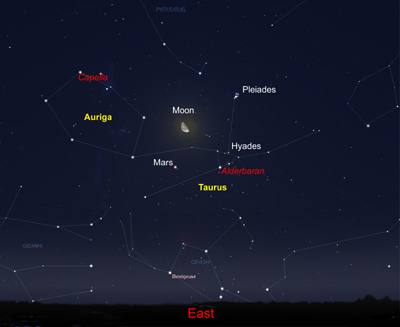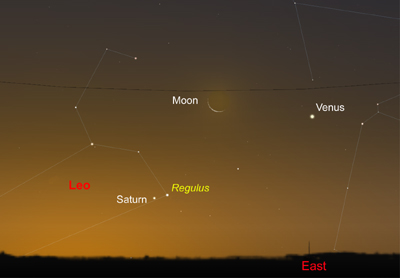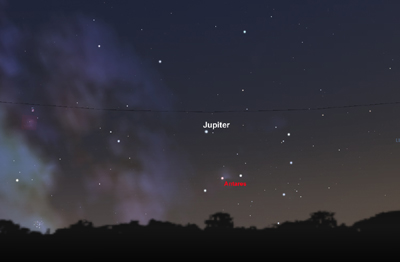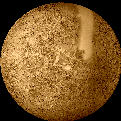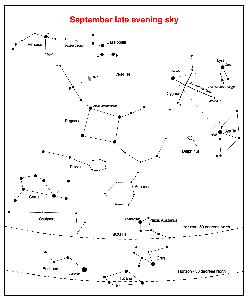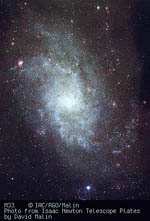The Night Sky September 2007
Compiled by Ian Morison
This page, updated monthly, will let you know some of the things that you can look out for in the night sky. It lists the phases of the Moon, where you will see the naked-eye planets and describes some of the prominent constellations in the night sky during the month.
Image of the Month
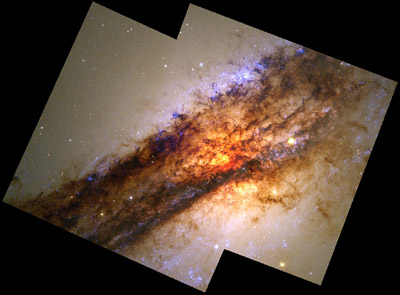
The active galaxy Centaurus A - click for full sized image
Image:E.J.Schreier (AIU)et al, HST, NASA
This is a mosaic of Hubble Space Telescope images of the centre of the active galaxy Centaurus A. This name was given to it by radio astronomers as it is the nearest Radio Galaxy, its radio emission (along with gamma and X-rays) being the result of matter falling in towards a super-massive black hole, having a mass a billion times that of our Sun, at its centre. It is thought to be the merger of an elliptical galaxy and a spiral galaxy in the last few billion years. It has the main charactistics of a large elliptical galaxy but having a massive dust lane superimposed across it.
The Moon
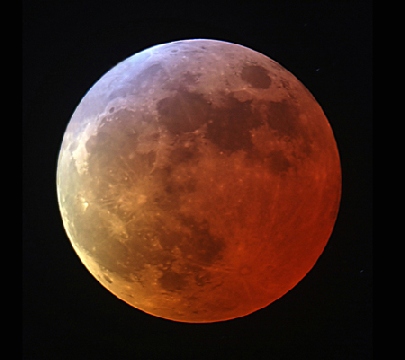
The passage of the Moon through the Earth's shadow March 2007: Cape Newwise 200 mm telescope and Nikon D80 camera.
Ian Morison, Jodrell Bank Observatory
| new | first quarter | full moon | last quarter |
|---|---|---|---|
| Sept 11th | Sept 19th | Sept 26th | Sept 04th |
Some Lunar Images by Ian Morison, Jodrell Bank Observatory: Lunar Images
Highlights of the Month
September 4th, 1am: Mars and the Third Quarter Moon
In the early morning on the 4th of September Mars will be seen below the third quarter Moon down to the left of the Hyades Cluster. The previous night the Moon will be in the region of the Pleiades Cluster.
September 9th before dawn: Venus the Moon and Saturn
Perhaps the best skyscape this month will be seen, if clear, in the east before dawn on the 9th of September. Venus will be shining brightly up and to the right of the thin crescent Moon whilst, below the Moon, Saturn and Regulus will be seen just one and a quarter degrees apart.
The Planets
Jupiter
Jupiter will be seen in the south-west as the Sun sets as the month begins, and this is really our last month to observe it for a while. At the beginning of the month it shines with a magnitude of -2.1 above and just to the left of the red star Antares in Scorpius. Though its disk its now reducing in size, from 38 down to 35 arc seconds during the month, there is still much detail to be seen. However Jupiter lies in the constellation Ophiuchus, part of which dips down between Scorpius and Sagittarius. Sadly, this is almost at the most southerly point of the ecliptic (the path of the Sun, and near to which the planets are found) so, this year, Jupiter has not be high in the sky for observers at our northern latitudes. This means that it will be seen through quite a substantial atmosphere and so our views will not be as good as when Jupiter is higher in the sky. There is a second problem in that the atmosphere acts somewhat like a prism with the blue image of Jupiter appearing about 4 arc seconds above the red image. This will both add "false colour" to the image and blur it as well. One should thus use colour filters to observe it at a particular part of the spectrum. Different colours can help bring out different aspects of the surface. Light blue will darken the red spot and make the equatorial bands more prominent, whilst a light yellow filter can help bring out detail in the polar regions. The refractive aspects of the atmosphere will make it difficult to photograph Jupiter with a Toucam or other colour webcam. The best results will come if red, green and blue images are obtained separately using colour filters. Even better results will be obtained with narrow band filters such as OIII for Green and H-Alpha for the red.
A small telescope (or even binoculars resting on a wall to steady them) will allow you to observe the 4 bright Galilean Moons, Io, Europa, Ganymede and Callisto, discovered by Galilo Galilei in 1610. Sometimes the Moons cast a shadow on the surface which can be seen as a black dot in moderate sized telescopes. A telescope will enable you to easily see the equatorial belts - clouds at differing altitudes - and you may also spot the great red spot, though it is not quite so prominent now as it can sometimes be.
Saturn
Saturn As September begins Saturn, close to the star Regulus in Leo, might just be glimpsed in the pre-dawn sky. On Sept 2nd, Saturn and Regulus lie within one degree of each other. They gradually move apart and by the end of the month Saturn is 3.6 degrees to the lower left of Regulus. At magnitude +0.6 (rising during the month to +0.7) Saturn will not be as bright this coming year as it sometimes is: the rings are closing (~ 9 degrees tilt to us )and thus there is less apparent reflecting area. A small telescope will easily show its moon, Titan, and show some bands around the surface, but you may well have to wait until the end of the month before they can be seen well as Saturn gradually rises earlier than the Sun. See also the highlight above.
Mercury
Mercury Mercury passed behind the Sun on August 15th, and is now just visible in evening sky about 20 to 30 minutes after sunset. It is very low above the horizon and not easy to spot. To have a chance, get to a location with a very low western horizon and observe where the Sun sets. With binoculars you may then be able to spot Mercury, at magnitude at -0.5 (but dropping down to magnitude zero during the month) just above the horizon to the left of where the Sun has set. (In the west in early September and west south-west at month end.)
Note that the blank region in the image above is simply because this part of Mercury's surface has not yet been imaged in detail.
Mars
Mars, in Taurus for most of the month, is now rising around 10 pm and rises to about 40 degrees elevation above the south south-east before dawn. Its disk is just 8 arc seconds across and it shines at magnitude +0.3 at the beginning of September. During the month its brightness increases to magnitude -0.1 and the disc increases to 9.6 arc seconds. We still need to wait a month or so before we see it well, but under good conditions the polar caps and Sytris Major (a prominent dark marking on the surface) should be visible in a small telescope. Mars will reach opposition in December - a highlight of the winter months
Venus
Venus may be spotted low in the north-east (at magnitude -4.4) just before dawn at the beginning of the month. Its disc will be ~ 53 arc seconds across. During the month it rises earlier and it brigthness rises to -4.8 on the 21st see highlight above and becomes quite easy to see as it rises some three hours before the Sun. A telescope will show a thin crescent at the beginning of the month which gradually fills out until 1/3rd of Venus's (now shrinking) disk is illuminated at the end of the month.
Find more planetary images and details about the Solar System: The Solar System
The Stars
The Evening September Sky
This map shows the constellations seen towards the south in late evening. To the south in early evening moving over to the west as the night progresses is the beautiful region of the Milky Way containing both Cygnus and Lyra. Below is Aquilla. The three bright stars Deneb (in Cygnus), Vega (in Lyra) and Altair (in Aquila) make up the "Summer Triangle". East of Cygnus is the great square of Pegasus - adjacent to Andromeda in which lies M31, the Andromeda Nebula. To the north lies "w" shaped Cassiopeia and Perseus.
The constellations Lyra and Cygnus
This month the constellations Lyra and Cygnus are seen almost overhead as darkness falls with their bright stars Vega, in Lyra, and Deneb, in Cygnus, making up the "summer triangle" of bright stars with Altair in the constellation Aquila below. (see sky chart above)
Lyra
Lyra is dominated by its brightest star Vega, the fifth brightest star in the sky. It is a blue-white star having a magnitude of 0.03, and lies 26 light years away. It weighs three times more than the Sun and is about 50 times brighter. It is thus burning up its nuclear fuel at a greater rate than the Sun and so will shine for a correspondingly shorter time. Vega is much younger than the Sun, perhaps only a few hundred million years old, and is surrounded by a cold,dark disc of dust in which an embryonic solar system is being formed!
There is a lovely double star called Epsilon Lyrae up and to the left of Vega. A pair of binoculars will show them up easily - you might even see them both with your unaided eye. In fact a telescope, provided the atmosphere is calm, shows that each of the two stars that you can see is a double star as well so it is called the double double!
Between Beta and Gamma Lyra lies a beautiful object called the Ring Nebula. It is the 57th object in the Messier Catalogue and so is also called M57. Such objects are called planetary nebulae as in a telescope they show a disc, rather like a planet. But in fact they are the remnants of stars, similar to our Sun, that have come to the end of their life and have blown off a shell of dust and gas around them. The Ring Nebula looks like a greenish smoke ring in a small telescope, but is not as impressive as it is shown in photographs in which you can also see the faint central "white dwarf" star which is the core of the original star which has collapsed down to about the size of the Earth. Still very hot this shines with a blue-white colour, but is cooling down and will eventually become dark and invisible - a "black dwarf"! Do click on the image below to see the large version - its wonderful!
M56 is an 8th magnitude Globular Cluster visible in binoculars roughly half way between Alberio (the head of the Swan) and Gamma Lyrae. It is 33,000 light years away and has a diameter of about 60 light years. It was first seen by Charles Messier in 1779 and became the 56th entry into his catalogue.
Cygnus
Cygnus, the Swan, is sometimes called the "Northern Cross" as it has a distinctive cross shape, but we normally think of it as a flying Swan. Deneb,the arabic word for "tail", is a 1.3 magnitude star which marks the tail of the swan. It is nearly 2000 light years away and appears so bright only because it gives out around 80,000 times as much light as our Sun. In fact if Deneb where as close as the brightest star in the northern sky, Sirius, it would appear as brilliant as the half moon and the sky would never be really dark when it was above the horizon!
The star, Albireo, which marks the head of the Swan is much fainter, but a beautiful sight in a small telescope. This shows that Albireo is made of two stars, amber and blue-green, which provide a wonderful colour contrast. With magnitudes 3.1 and 5.1 they are regarded as the most beautiful double star that can be seen in the sky.
Cygnus lies along the line of the Milky Way, the disk of our own Galaxy, and provides a wealth of stars and clusters to observe. Just to the left of the line joining Deneb and Sadr, the star at the centre of the outstretched wings, you may, under very clear dark skys, see a region which is darker than the surroundings. This is called the Cygnus Rift and is caused by the obscuration of light from distant stars by a lane of dust in our local spiral arm. the dust comes from elements such as carbon which have been built up in stars and ejected into space in explosions that give rise to objects such as the planetary nebula M57 described above.
There is a beautiful region of nebulosity up and to the left of Deneb which is visible with binoculars in a very dark and clear sky. Photographs show an outline that looks like North America - hence its name the North America Nebula. Just to its right is a less bright region that looks like a Pelican, with a long beak and dark eye, so not surprisingly this is called the Pelican Nebula. The photograph below shows them well.
Brocchi's Cluster An easy object to spot with binoculars in Gygnus is "Brocchi's Cluster", often called "The Coathanger",although it appears upside down in the sky! Follow down the neck of the swan to the star Alberio, then sweep down and to its lower left. You should easily spot it against the dark dust lane behind.
The constellations Pegasus and Andromeda
Pegasus
The Square of Pegasus is in the south during the evening and forms the body of the winged horse. The square is marked by 4 stars of 2nd and 3rd magnitude, with the top left hand one actually forming part of the constellation Andromeda. The sides of the square are almost 15 degrees across, about the width of a clentched fist, but it contains few stars visibe to the naked eye. If you can see 5 then you know that the sky is both dark and transparent! Three stars drop down to the right of the bottom right hand corner of the square marked by Alpha Pegasi, Markab. A brighter star Epsilon Pegasi is then a little up to the right, at 2nd magnitude the brightest star in this part of the sky. A little further up and to the right is the Globular Cluster M15. It is just too faint to be seen with the naked eye, but binoculars show it clearly as a fuzzy patch of light just to the right of a 6th magnitude star.
Andromeda
The stars of Andromeda arc up and to the left of the top left star of the square, Sirra or Alpha Andromedae. The most dramatic object in this constellation is M31, the Andromeda Nebula. It is a great spiral galaxy, similar to, but somewhat larger than, our galaxy and lies about 2.5 million light years from us. It can be seen with the naked eye as a faint elliptical glow as long as the sky is reasonably clear and dark. Move up and to the left two stars from Sirra, these are Pi amd Mu Andromedae. Then move your view through a rightangle to the right of Mu by about one field of view of a pair of binoculars and you should be able to see it easily. M31 contains about twice as many stars as our own galaxy, the Milky Way, and together they are the two largest members of our own Local Group of about 3 dozen galaxies.
M33 in Triangulum
If, using something like 8 by 40 binoculars, you have seen M31 as described above, it might well be worth searching for M33 in Triangulum. Triangulum is
the small faint constellation just below Andromeda. Start on M31, drop down to Mu Andromedae and keep on going in the same direction by the same distance as you have moved from M31 to Mu Andromedae. Under excellent seeing conditions (ie., very dark and clear skies) you should be able to see what looks like a little piece of tissue paper stuck on the sky or a faint cloud. It appears to have uniform brightness and shows no structure. The shape is irregular in outline - by no means oval in shape and covers an area about twice the size of the Moon. It is said that it is just visible to the unaided eye, so it the most distant object in the Universe that the eye can see. The distance is now thought to be 3.0 Million light years - just greater than that of M31.


